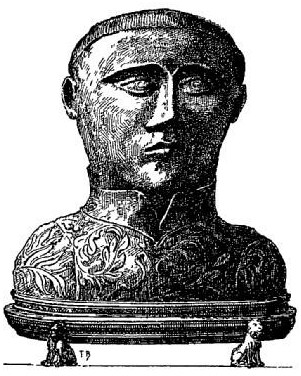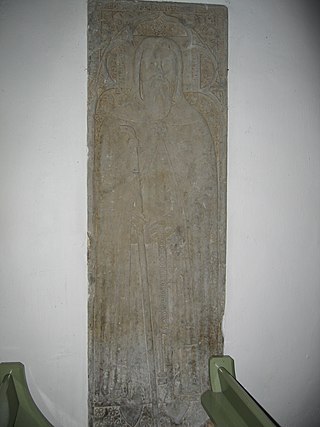Related Research Articles

Piran or Pyran, died c. 480, was a 5th-century Cornish abbot and saint, possibly of Irish origin. He is the patron saint of tin-miners, and is also generally regarded as the patron saint of Cornwall, although Michael and Petroc also have some claim to this title.
Geraint, known in Latin as Gerontius, was a King of Dumnonia who ruled in the early 8th century. During his reign, it is believed that Dumnonia came repeatedly into conflict with the neighbouring Anglo-Saxon Kingdom of Wessex. Geraint was the last recorded king of a unified Dumnonia, and was called King of the Welsh by the Anglo-Saxon Chronicle. Subsequent kings of Dumnonia reigned over an area that was eventually reduced to the limits of present-day Cornwall.
Cador is a legendary Duke of Cornwall, known chiefly through Geoffrey of Monmouth's pseudohistorical Historia Regum Britanniae and previous manuscript sources such as the Life of Carantoc. In Welsh genealogical records, he appears as Cado (Cadwr), the son of Cornish king Geraint. Early sources present him as a relative of King Arthur, though the details of their kinship are usually left unspecified.

Brychan Brycheiniog was a legendary 5th-century king of Brycheiniog in Mid Wales.

Gwinear, Guigner, was a Celtic martyr, one of only two early Cornish saints whose biographies survived the Reformation. The Life of Gwinear was written in the early 14th century by a priest named Anselm, and has sometimes been printed among the works of Anselm of Canterbury. His feast day is March 23.

Winwaloe was the founder and first abbot of Landévennec Abbey, also known as the Monastery of Winwaloe. It was just south of Brest in Brittany, now part of France.

Saint Cuby or Saint Cybi was a 6th-century Cornish bishop, saint and, briefly, king, who worked largely in Cornwall and North Wales: his biography is recorded in two slightly variant medieval 'lives'.

Saint Carantoc, also anglicized as Carantock, Carannog and by other spellings, was a 6th-century abbot, confessor, and saint in Wales and the West Country. He is credited with founding Llangrannog, Ceredigion, Wales and St Carantoc's Church, Crantock. His name is listed amongst the Cornish Saints. Carantoc's is one of five insular saints' lives and two Breton ones that mention Arthur in contexts that may be independent of Geoffrey of Monmouth's Historia Regum Britanniae. He is venerated by the Eastern Orthodox Church and Roman Catholic Church.
Erbin of Dumnonia was a 5th-century King of Dumnonia and saint of Wales.

St Levan Church, St Levan is a parish church in the Church of England located in St Levan, Cornwall, United Kingdom. Until 1864 the church was a chapelry of the Royal Peculiar of the Deanery of St Buryan. It is now part of the united benefice of St Buryan and St Sennen.

Iestyn was a Welsh hermit and confessor in the 6th or 7th century who is venerated as a saint. He was the founder of two churches, one in Gwynedd and another in Anglesey, both in north Wales.

Edern ap Nudd was a knight of the Round Table in Arthur's court in early Arthurian tradition. As the son of Nudd, he is the brother of Gwyn, Creiddylad, and Owain ap Nudd. In French romances, he is sometimes made the king of a separate realm. As St Edern, he has two churches dedicated to him in Wales.
Caffo was a sixth-century Christian in Anglesey, north Wales, who is venerated as a saint and martyr. The son of a king from northern Britain who took shelter in Anglesey, Caffo was a companion of St Cybi, and is mentioned as carrying a red-hot coal in his clothes to Cybi without his clothes getting burnt. After leaving Cybi, Caffo was killed by shepherds in the south of Anglesey, possibly acting in retaliation for insults Caffo's brother had paid to the local ruler. The area where he died has a village, Llangaffo, named after him, as well as the parish church of St Caffo, Llangaffo.
Adwen or Adwenna was a 5th-century Christian virgin and saint. She is recorded as a daughter of Brychan, king of Brycheiniog in south Wales, in the Cornish Life of Saint Nectan and in Robert Hunt's collection of Cornish legends. These sources associate her with the establishment of the parish of Advent in Cornwall.

Tetha, also known as Teath, Tecla, and by a variety of other names, was a 5th-century virgin and saint in Wales and Cornwall. She is associated with the parish church of St Teath in Cornwall. Baring-Gould gives her feast day as 27 October, but this has been called a mistaken conflation with Saint Ia. In 1878, it was held on the movable feast of Whit Tuesday. Other sources place it on 1 May, 6 September, and (mistakenly) 15 January. It is no longer observed by either the Anglican or Catholic church in Wales.
Cynyr Ceinfarfog was a ruler of the Kingdom of Dyfed in Wales. He was known as Cunoricus in Latin and in English as Kendrick or as Cynyr the Red.
Wenna was a 6th-century queen and saint of Cornwall and Wales. She founded St Wenna's Church in Morval, Cornwall. The fest in Catholic Church: October, 18.
References
- ↑ "Celtic and Old English Saints - 18 October". celticsaints.org.
- 1 2 Baring-Gould, Sabine. The Lives of the British Saints, vol. IV. London. The Honourable Society of Cymmrodorion, 1913, p. 180
 This article incorporates text from this source, which is in the public domain .
This article incorporates text from this source, which is in the public domain . - ↑ Lloyd, John Edward (1959). "CYBI (fl. 550), saint". Dictionary of Welsh Biography . National Library of Wales.
- ↑ Baring-Gould, Sabine. "A Book of Cornwall', Methuen, 1906, p. 211
- ↑ Journal of the Royal Institution of Cornwall, Volume 19, Royal Institution of Cornwall, 1912, p. 430
- ↑ Doble, G. H., (1960) The Saints of Cornwall: part 1. Truro: Dean and Chapter; pp. 3-9
- ↑ Watts, Victor (2010). The Cambridge Dictionary of English Place-names (1st paperback ed.). Cambridge University Press. p. 520. ISBN 978-0-521-16855-7.